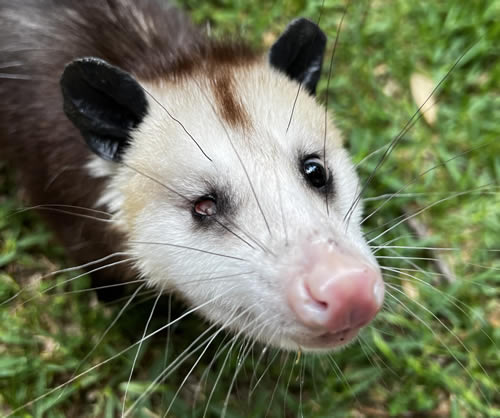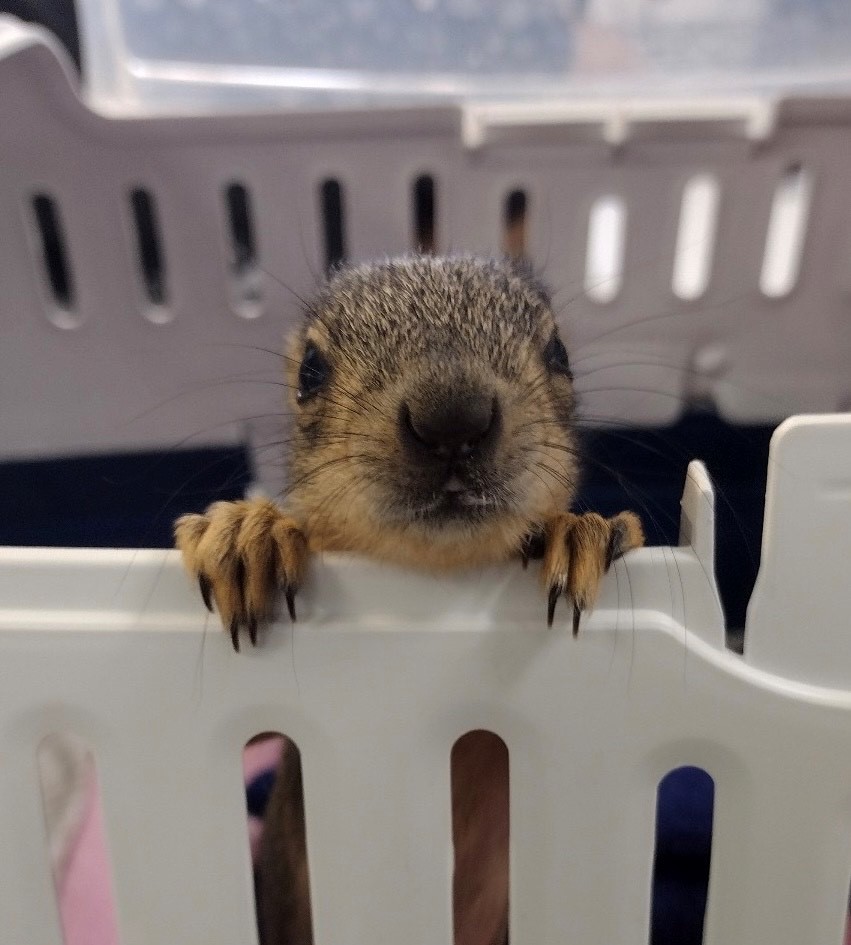Pet Safety with Wildlife
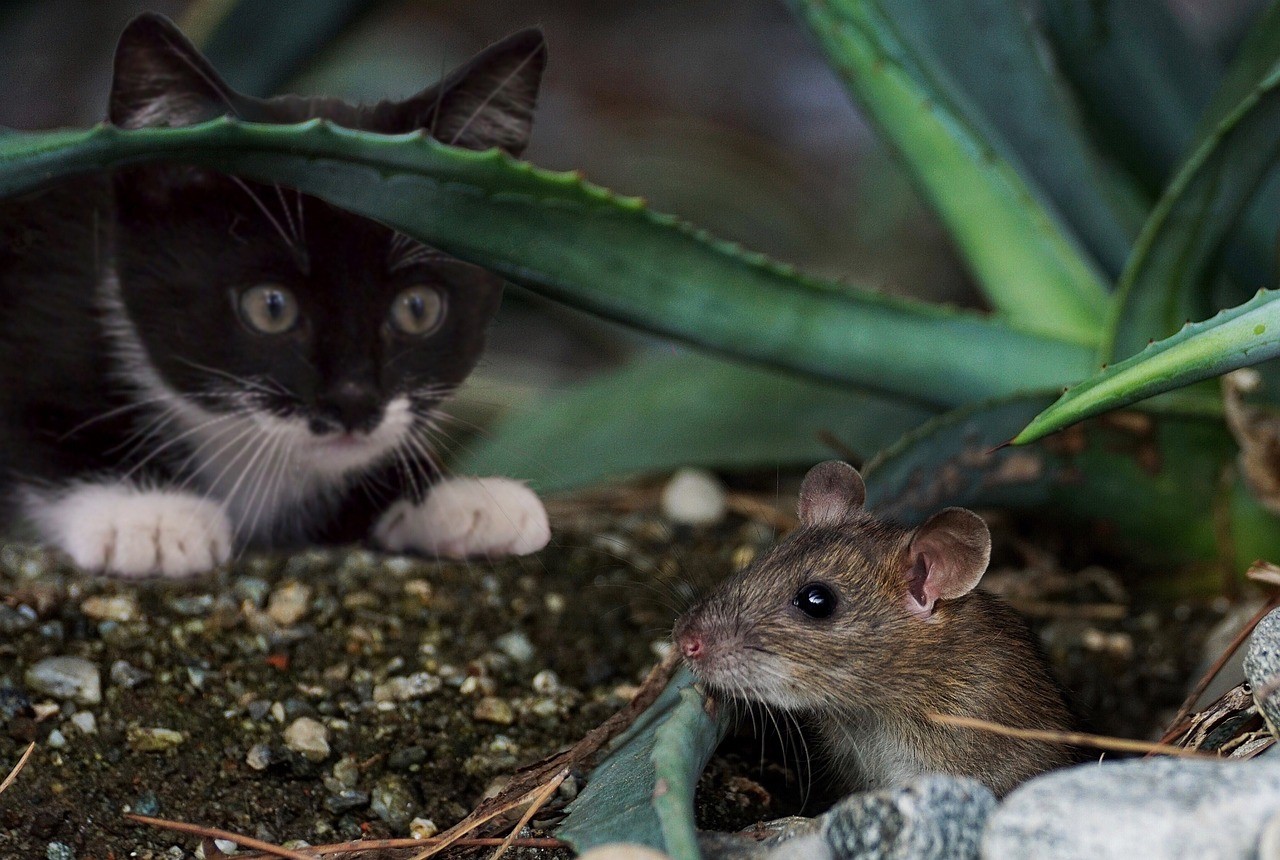
General Information
Domestic pets and wildlife do not mix, however, they both deserve to enjoy the great outdoors separately. It is extremely important to remember that while wildlife can be cute, they behave and live very different lives from our pets at home. Never under any circumstances should you allow your pets to chase, investigate, or harass wildlife. We, as pet owners, have a responsibility to keep both our pets and the local wildlife safe. While accidents do happen, and not all incidents are 100% preventable, there are steps you can take to help prevent encounters before they occur.
Note: wild animals are illegal to keep as pets and do not make good companions themselves. People often assume that with the help of humans, they are able to thrive in a domestic setting, which couldn’t be further from the truth. Wild animals have needs, instincts, and behaviors that are inseparably tied to both their natural habitat and a free-living state.
Habituation is a process where animals gradually become more comfortable with situations they would normally avoid, and is dangerous for both humans and wildlife alike. Habituated animals cannot be returned to the wild, because they are likely to become nuisances or an outright danger to humans, which in turn jeopardizes the animals.
Additionally, domestic pets do not belong in the wild. Releasing domestic animals into the wild is oftentimes fatal to the pets involved because they lack the necessary skillset to survive on their own. In some cases, certain domestic species may be invasive and outcompete native species for resources, proving harmful to native wildlife.
HELP US KEEP WILDLIFE WILD!
Resources for Rehoming Domestic Animals
|
ANIMAL TYPE |
NAME |
LOCATION |
CONTACT INFO |
|
Cats, dogs, peacocks, and barn animals. |
SPCA |
7007 Old Katy Rd. Houston, TX 77024 |
713-869-7722 |
|
Cats/dogs |
Friends for Life |
107 E. 22nd Street, Houston, TX 77008 |
713-863-9835 |
|
Cats, dogs, and domestic rabbits |
CAPS |
17555 Katy Fwy, Houston, TX 77094 |
281-497-0591 |
|
Cats, dogs, and domestic rabbits |
Houston Humane Society |
14700 Almeda Rd., Houston, TX 77053 |
713-433-6421 |
|
Domestic Rabbits |
Bunny Buddies |
713-822-8256 |
|
|
Exotic (pet) mammal and reptile surrender |
Gina Distledorf* |
Houston, TX |
502-413-1055 |
|
Snakes |
Clint Pustejuvsky |
Texas |
713-934-7668 |
|
Pigeons and Domestic Rabbits |
Quality Feed |
1813 Luzon St, Houston, TX 77009 |
713-862-2323 |
|
Exotic Pet Birds |
Adventures in Birds |
7414 Westview Dr, Houston, TX 77055 |
713-681-5299 |
*Gina is a school teacher during the week, and may not respond during normal school business hours.
General Tips To Minimize Interactions Between Wildlife and Pets:
- You should never allow your pet to chase, investigate, or harass wildlife.
- Pick up any trash and pet waste in your yard, as this may unintentionally attract or harm wildlife.
- Fencing that has a smooth surface, and is above 6 feet tall will help prevent certain animals from climbing over and visiting your backyard.
- Avoid feeding pets outdoors, as sometimes the smell of the food may linger and any wildlife in the area may mistake it for a potential food source.
- If you absolutely need to feed outdoors, consider investing in an air-tight storage container for pet food and be mindful to clean the area of any leftover food/residue.
- Consider purchasing a coyote roller as a humane source to deter wildlife from climbing over/landing on your fence line. Alternatively, if your pet is an escape artist, it’ll help keep them in the yard.
- Closely supervise your pets when they’re outside.
- Before letting dogs outside, especially during dawn/dusk hours, do a perimeter check of the yard to see if any wildlife has decided to come hang out. Making loud noises as you walk around outside, such as clapping or stomping your feet from a distance, may help scare off/deter animals from entering the yard.
- When in doubt, keep your dog on a leash when going out into the yard with them. An ounce of prevention is worth a pound of cure.
Getting Rid of Skunk Odor
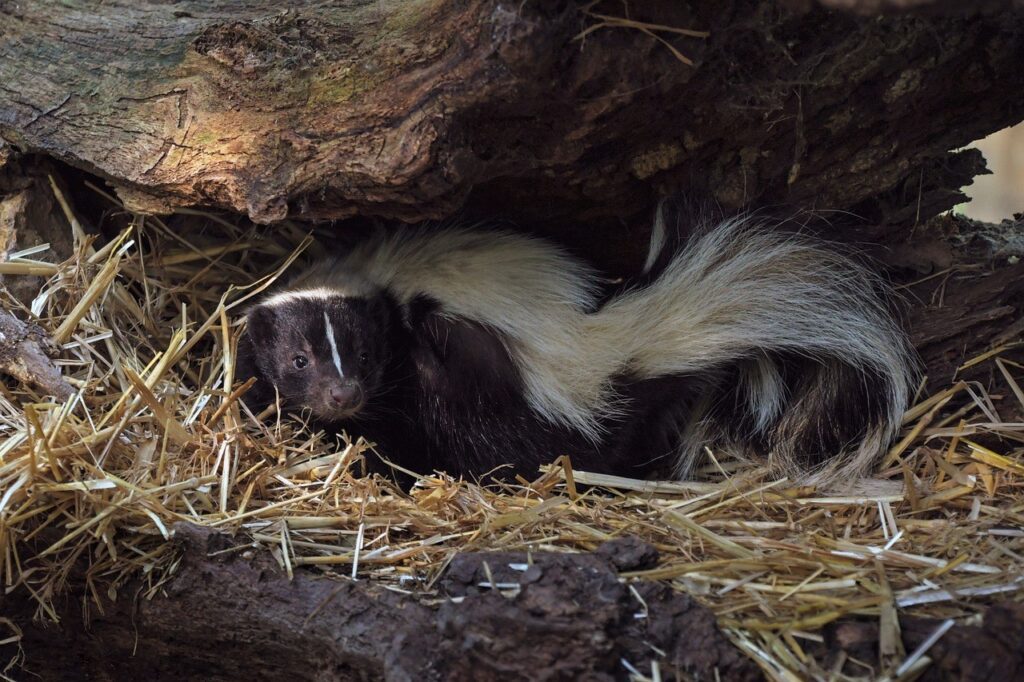
What you’ll need to get started:
- 4 cups hydrogen peroxide
- ⅓ cup baking soda
- 1 teaspoon of Dawn dish soap
Do not make this mixture ahead of time and store it or it may explode in the bottle.
Alternatively, if you don’t have baking soda, peroxide, and dish soap on hand, vinegar diluted with water can be used instead.
- Wearing rubber gloves, apply the mixture to your pet as soon as possible after they’ve been sprayed by the skunk.
- Rub the mix through their fur and let it sit for anywhere between 2-4 minutes, taking care not to let it sit for too long or it may bleach your pet's fur.
- Rinse the mixture thoroughly with warm water.
- Shampoo your pet as you normally would and rinse one more time.
Snake Safety
- Keep your grass in the yard short.
- Remove any rock or brush piles that may serve as a hiding place for snakes.
- Store any firewood away from your house.
- If you have bird feeders, clean up any spilled seed/feed from underneath. The birdseed on the ground will attract small mammals, which will in turn attract snakes.
While you can take measures to help your pets avoid a snake bite, accidents do happen and bites are not 100% preventable. Below are some steps you can take in the event that your pet does get bit.
Rattlesnake Vaccines
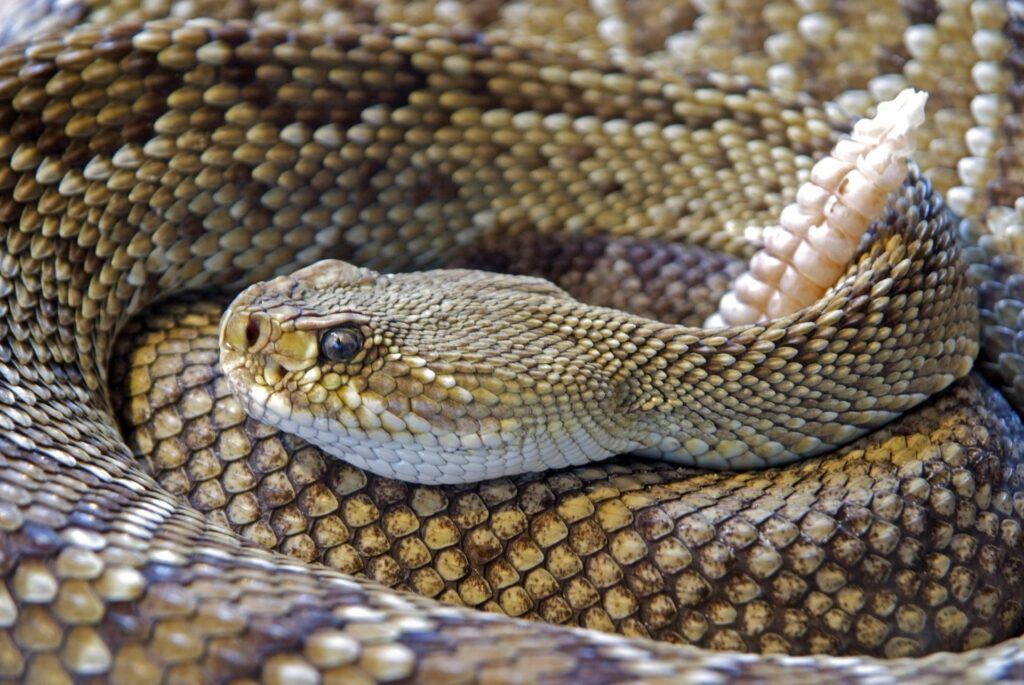
As a preventative measure, rattlesnake vaccines are available to help lessen the reaction that a dog may have to snake venom. The vaccine works by introducing an inactive version of the rattlesnake venom to the dog’s immune system. This, in turn, causes the immune system to produce antibodies against the venom, which will help mitigate the reaction a dog may have to a potential bite.
Although the vaccine does lessen the severity of a snake bite, timely, emergency medical treatment is still necessary and should be your number one priority if a snake bite occurs.
My pet was bitten by a snake, what do I do?
Find an emergency veterinarian in the area: Emergency Vets in Texas | Find Animal Hospitals Near You
- Seek treatment at the nearest emergency vet IMMEDIATELY.
- Don’t panic. Remain calm and move your pet away from the snake. Do not attempt to pick up the snake to identify it. Instead, consider snapping a quick photo to show your veterinarian.
- Don’t cut into the bite area, apply ice or heat, a tourniquet, or suck the venom out. This may do more harm than good and delay treatment.
- Keep the bite area below heart level if possible.
- Restrain and calm your pet.
Coyote Safety With Pets
- Always walk your dog on a leash (6ft or less), if you notice a coyote, pick your dog up or place them behind you before hazing the coyote.
- To haze the coyote: yell, stomp your feet, use a homemade noisemaker, and appear big and bad.
- It may be helpful to carry Pet corrector which is a can with compressed air that makes a startling hissing noise when activated.
- Products like the Coyote Vest and Coyote Collar act as a visual and sensory deterrent to help protect your pet if they encounter a coyote.
- Never leave pets outside unattended.
Coexisting with Nesting Rabbits
Most people will not even know they have a nest of rabbits in their backyard. Mom does not normally visit during the daytime to avoid drawing attention to the fragile babies in the nest.
Thankfully, it’s easy to coexist.
You can use a laundry basket turned over, with a 6-inch hole cut out in the front. Place the basket over the nest area and weigh the top with bricks or a heavy object that won’t crush the basket. This should only be up for 3-4 weeks at maximum. You can lay a wooden pallet over the nest if you don't have a laundry basket.
The babies will typically start to explore outside of the nest about 3 weeks after they’re born, if you do happen to see any of them in the backyard before you let your dog(s) out to potty, try walking outside alone and clapping to alert the bunnies that a predator is nearby. If possible, take the dog(s) out on a leash until the bunnies have left the yard.
If a dog or cat has caught one of the babies in its mouth or dug up the nest, please call our hotline at 713-468-8972 to find the closest wildlife rehabber or center to provide care.


Dog Specific:
General Tips:
Vaccinate your dog. Yearly vaccinations with the appropriate booster shots in between help prevent the spread and transfer of zoonotic diseases such as rabies and distemper. Below is a list of the 5 core vaccines.
- Canine Distemper Virus
- Canine Parvovirus
- Canine adenovirus-2 (hepatitis)
- Rabies Virus
- Canine Parainfluenza
- If you have a breed with a high prey-drive, consider giving them an outlet that doesn’t involve chasing critters. A flirt pole (giant cat toy for dogs) is a great outlet for pups who love to chase/catch things.
- Invest in a long-line for outdoor activities.This way, your pet is still leashed but has more freedom to move around on something safer than a flexi-leash.
- ALWAYS remember to follow leash laws!
Teaching your dog “leave it”
Note: this exercise isn’t solely applicable to snakes, and can be used in a variety of situations where you encounter wildlife.
For this exercise, you’ll need a rubber snake, some fishing line or string, and a high-value reward (cut-up hot dogs, boiled and shredded chicken breast, etc.)
- Start by placing the rubber snake on the ground and approaching with your dog on a leash. Tell them to “leave it” as you approach.
- If their attention breaks away from the snake, mark the behavior with a “yes!” and treat it as soon as they look at you. When praising, move in the opposite direction of the “snake” on the ground to set your pup up for success.
- If food isn’t a huge motivator for your dog, try using their favorite toy as a reward for this exercise instead.
- Eventually, your dog will hear the “leave it” cue and associate it with a tasty snack or praise coming their way. The idea here is to make yourself a higher value than the “snake” in front of you.
- Once your dog picks up the idea of “leave it”, have a friend tie a fishing line or thin string to the snake and begin to wiggle it while you and your dog go through the exercise again. Repeat the steps above and continue to practice the game on a leash.
Teaching Recall
Recall means “come to me and sit” and is one of the MOST important commands to teach your dog. Having a consistent recall is vital in situations where your dog may be tempted to chase wildlife or put themselves in a potentially unsafe situation. Below are tips to help your dog come back to you when called.
Note: Practice recall on a long line ( at least 20 ft, but the longer the better) just in case your dog decides they don’t want to come back. That way you still have something to grab on to if you need to pull them back to you.
Additionally, ALWAYS praise your dog for coming back to you, even if it isn’t the first time you’ve called them. Never scold your dog for eventually making it back to you.
- Consistently practice rewarding your dog in outdoor settings for coming back when you call them.
- Being more exciting/fun than the environment around you is KEY! Make sure this training is fun, short, and sweet, about 15-minute sessions 3-4x per day.
- If your dog tends to slip out of their collar to go on adventures, consider investing in a properly fitted martingale collar that they can’t back out of.
Teaching your dog Door Manners.
Door manners are a great way to help keep both your dog and any wildlife in the front or backyard safe. The goal of this exercise is to have your dog sit and wait before crossing the threshold of the door. It can be extremely useful if you need to scope out the yard before letting your dog out.
- Start with the door closed and have your dog “sit” about 3-4 feet away from the door. Open the door slowly, if your dog gets up from their sitting position, close the door, and have them sit again. (If your dog knows “stay” feel free to use it here).
- Have them repeat this process until you’re able to open the door all the way and they remain in a sitting position. Patience is key here, and if your dog is struggling with holding still, take baby steps with this exercise and work up to the end goal (ex: working on holding the sit for longer durations)
- As a test, walk out a few feet into the yard before releasing them from the sit command, lots of praise and fun when they get it right!
- Consistency and patience are key here!
Tips for Recreation on Trails:
- Remember to stay on the marked trails! Going off-trail, you’re more likely to encounter or startle an animal protecting its den.
- If you’re hiking in an area where wildcats or bears may be present, shout or sing loudly when on the trail to alert them of your presence. Additionally, you can have your dog wear bells to help make extra noise.
- If confronted, don’t panic, and don’t run! Face the animal and slowly back away with your dog, if possible, pick up your pup and hold them while you back away. Running may cause certain animals to view you and your dog as prey.
- Report any sick or aggressive animals to the Texas Department of Health immediately.
- Texas Dept of Health (Houston Region) - 713-767-3300
- Make sure your dog’s ID tags are current and visible in case you lose sight of them or become separated at any point during your hike.
- Bring plenty of treats and your dog’s favorite noisy toy in case you need to search for them in the event that you get separated.
Resources to find dog-friendly hiking trails in Houston:
Cat Specific
The Problem With “Outdoor” Cats:
According to the Cornell Lab of Ornithology, in the United States alone, there are an estimated 60-100 million free-ranging, unowned cats. Annually, these outdoor cats are estimated to kill anywhere between 1.3-4 billion birds and approximately 22.3 billion mammals each year.
Domestic cats are not native to North America and were brought over on ships coming from Europe, tagging along with Christopher Columbus, the settlers of Jamestown, and even aboard the Mayflower.
The International Union for Conservation of Nature lists domestic outdoor cats as one of the world’s worst non-native invasive species. With help from humans, outdoor cats exist at much higher densities than native predators such as foxes, owls, hawks, etc.
The average life expectancy of an outdoor cat is four years, while their indoor counterparts have a life expectancy of 16+ years. Outdoor cats have a significantly higher mortality rate than indoor cats because of the risks they face daily.
Diseases that outdoor cats risk both contracting and spreading may include but are not limited to:
- Rabies
- Toxoplasmosis
- Feline Leukemia
- Feline Immunodeficiency Virus (FIV)
- Feline Herpes
Keeping domestic cats indoors is the safest and most humane way to benefit both cat and wildlife populations alike.
If your cat likes to explore the backyard while under supervision, a bird-safe cat collar is a humane and effective way to keep your cat from successfully hunting. The collar’s bright colors help birds more effectively spot a cat stalking them.
Birdsbesafe Cat Collars | Bird Collar For Cats | Protect Birds


How to help cats feel more comfortable indoors:
- Provide toys and play with your cat
- Provide scratching posts around the house
- Cat “TV” - consider setting up a bird feeder in your backyard at least 10 feet away from any windows, it will provide hours of entertainment in a manner that’s safe for both your cat and local wildlife.
- Make sure that the window you choose is secure and that any blind strings are tucked in out of the way.
- Building a screened-in porch area or “Catio” for your cat to explore the outdoors in a controlled environment.
- Walk your cat on a leash and harness, while this may not be effective for all cats, some seem to really enjoy it! Get them acclimated to walking on a leash inside of the house before stepping outside for adventures.
- Plant a cat-safe garden inside! Cats enjoy a variety of plants such as wheatgrass, catnip, alfalfa, and oat grass).
Protecting the Local Wildlife in your Yard from Outdoor Cats
- Providing cover, as birds and other wildlife will rely on dense vegetation to hide from predators. Additionally, native plants will offer nesting sites and a food source.
- Place any feeders or bird baths at least 10-12 ft away from any potential hiding places for cats. They need the open space to be able to see the cat coming, so they have time to flee. Look for open spaces in your yard that don’t have any cover nearby.
- If cats are actively stalking your feeders, the best solution may be to take down the feeder and opt to feed the birds naturally (focus on feeding birds naturally through native plants that provide berries, seeds, and insects).
- Putting up a fence- most cats will not be able to jump a 6-foot fence on their own, especially if it has a texture like smooth wood or vinyl, as they won’t be able to get a good grip on it to climb over. A coyote roller installed along the top of the fence would work well here too.
- Motion detector lights may be effective at deterring cats from your yard, but if you’ve tried those and they haven’t worked, try experimenting with motion detector sprinklers.

